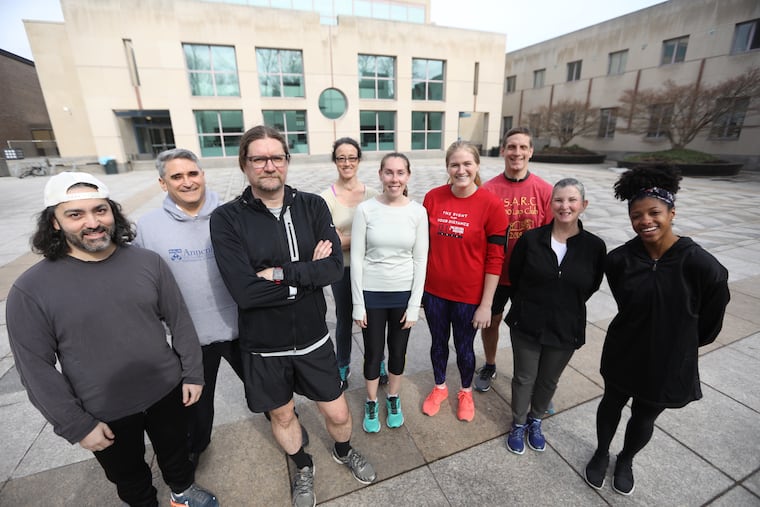Run, walk, and talk with strangers until they’re friends, and you’ll live longer, feel better, and learn more stuff.
“People are better at showing up to exercise when they’re motivated to keep up with, or maybe even beat, their friends.”

I was thin my whole life until suddenly I wasn’t. I figured it was just a part of aging.
I went into my late 30s averting my eyes from mirrors when I walked past, not wanting to see who was looking back. I got plantar fasciitis, a foot injury associated with weight gain, which caused me to start using a cane. I had trouble going up and down stairs and would pause on landings, pretending to be checking messages so people wouldn’t know that I was really out of breath.
In 2012, a barrage of humiliating comments from strangers about my weight in the comments section of a YouTube video was the straw that drove me to the gym. Fueled by anger and dread, I worked out incessantly, lost 40 pounds, and chose running as a way I hoped would keep it off. I yearned to be an active person, and in the beginning it was sheer force of will.
But the first time I ran through the streets of Philadelphia with my new, slimmer, suddenly more athletic body, I felt unstoppable. It was like flying. Who takes a bus 20 blocks? I’ll run! Who is this new person who burns through a pair of sneakers every three months and whose pants no longer fit? Not only did the pounds stay off, but I discovered unexpected benefits, too. I found a lifestyle, and I found my people.
I discovered them on Philadelphia’s miles of beautiful running trails: places like the Schuylkill River Trail, Boxer’s Trail, the Woodlands Cemetery, Belmont Plateau. I found them at races, I found them in running stores. And the more I ran, the faster I got. At some point in there I stopped weighing myself, and my metrics became speed and distance. Could I run faster? Could I run farther? Could I leave this race with a medal?
» READ MORE: After 50 years, this Bridgeport club is still giving Alabama football - and others - a boost | Mike Sielski
Running itself never felt pleasant, but having run delivered a sense of accomplishment that became powerfully addictive. And not having run actually felt bad. I spend a lot of time sitting at a desk. I soon realized that taking a 30-minute run in the middle of the day and a quick shower before getting back to work made me feel better than eating pizza while answering emails.
I invited other people to run with me — anybody who lived or worked nearby. “Hey! I’m running at NOON come with me!” I started a mailing list, and 100 neighbors signed up. This lunchtime running club was how I got to know Natalie Herbert, a Ph.D. student at Penn’s Annenberg School for Communication who became our unofficial coach.
She’d helped study the ways that social groups affected people’s workout activities, and her ideas started to impact the way we exercised. “People are better at showing up to exercise,” she told us, “when they’re motivated to keep up with, or maybe even beat, their friends.”
It proved to be true. People would lament on our email message board that it seemed too hot or too cold, and then others would offer to run a certain pace or distance if someone else did. On days where I had no desire to go outside and run, the group would motivate me to get up from my desk at noon, put on my shoes, and join them.
In the beginning there were many tentative members, interested in the idea but worried they wouldn’t be able to keep up. So we organized a Couch-to-5k: an eight-week program that, through incremental training, takes people from zero — the couch — to running a 3-mile race. After our first 5k, we kept training — for the Broad Street Run, Philadelphia’s iconic 10-mile race. It was wonderful to see people who just a few months ago had trouble running for 30 seconds, crossing the finish line after running 10 miles through the heart of the city.
» READ MORE: ‘Sisters’ adopted from China reunite outside Philadelphia
You can’t prevent getting older, but regular aerobic exercise can slow down the side effects of aging. The Department of Health recommends 75 minutes of aerobic exercise per week. Which seems daunting, but it’s less than three 30-minute runs with friends.
We strove to keep things interesting for people. With the help of computer programmer and brain expert Dr. Matt O’Donnell, the group hatched “Ideas in Motion” — a running lecture series. Each month we find an expert to give a four-minute, scripted talk about a topic of their choice, followed by a 15-minute Q&A, all while running. It’s like a TED talk — at 5 mph. This helps keep some runs special, making people feel extra motivated to come out.
“The best part about this club,” Natalie said, “is that [fitness] goals differ, but the camaraderie does not. We know that everyone benefits from physical activity of different intensity, for any duration, in different ways, with both immediate and long-term health benefits. Each of those steps toward your fitness goals is made easier when surrounded by friends.”
Want to start your own lunchtime running club? Google Groups is an easy-to-use mailing list platform, but you could also use Slack, Microsoft Teams, WhatsApp, or most any social media application for organizing and keeping in touch with people nearby.
Kyle Cassidy is a writer and photographer from Philadelphia. Find him at kylecassidy.com and @kylecassidy on social media.